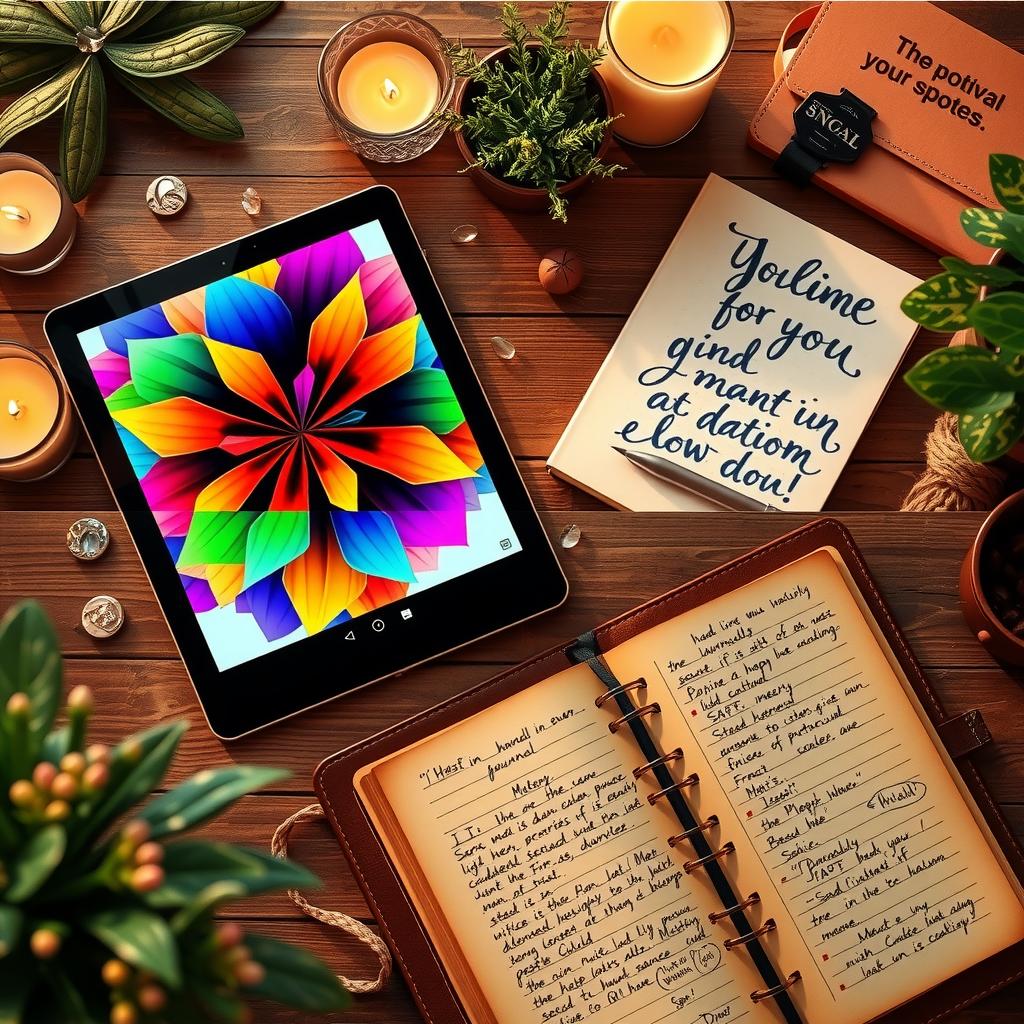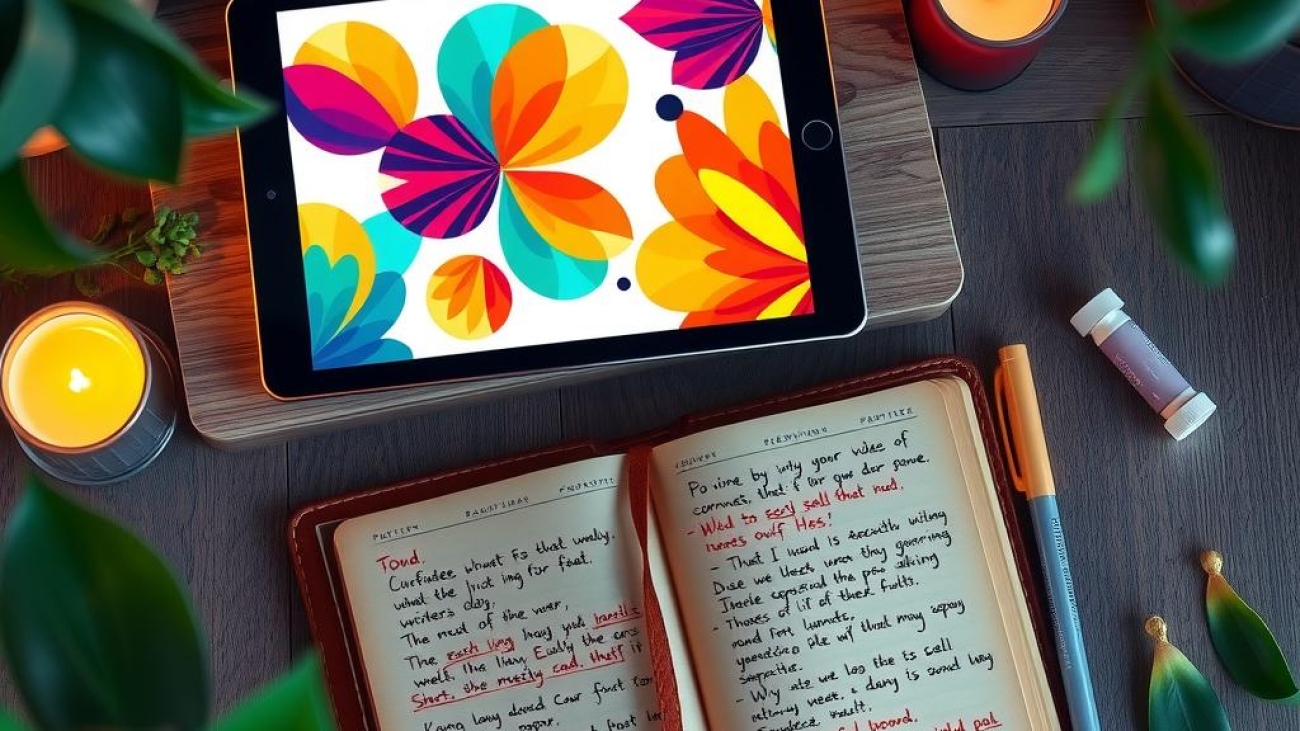In today’s fast-paced digital world, individuals often find themselves grappling with the complexities of their emotions and mental wellness. As mental health awareness grows, many are turning to journaling as a vital tool for emotional expression and self-reflection. However, an intriguing question arises: should one embrace traditional paper journaling or opt for digital journaling methods? This blog post delves into the mental health comparison between these two approaches, exploring their unique advantages and challenges while shedding light on how they serve as effective self-reflection tools.
Both forms of journaling offer distinct pathways to enhance one’s understanding of personal thoughts and feelings. While paper-based journals have long been praised for their tactile experience—inviting users to slow down and engage physically with the writing process—digital platforms promise convenience and accessibility that align well with modern lifestyles. Each method has its own set of journaling benefits, making it essential for readers to weigh which option may better suit their individual needs in fostering emotional clarity.
Furthermore, this exploration poses crucial implications for those seeking therapeutic avenues through writing. By examining the nuances between paper versus digital formats in terms of usability, privacy, and user engagement, readers will uncover insights that could significantly impact their approach to maintaining mental wellness. The objective is not merely to advocate one format over another but rather to illuminate how each can facilitate meaningful growth through consistent practice.
As we transition into a comprehensive analysis of both modalities, consider your own preferences: do you relish the feel of pen against paper or does typing on a screen resonate more? By unpacking this topic further, readers will be equipped with knowledge that empowers them in choosing a journaling style tailored specifically for promoting resilience amidst life’s challenges—a choice that ultimately fosters deeper connections with oneself through thoughtful introspection.

Key Points:
-
Title of the point: Understanding Digital Journaling
Digital journaling has emerged as a popular option for many individuals seeking effective self-reflection tools. This method offers distinct advantages such as accessibility and organization, which can significantly enhance one’s mental wellness. The ability to easily edit entries allows users to refine their thoughts while incorporating multimedia elements fosters a more engaging experience. Additionally, digital platforms often provide features like reminders that encourage consistent writing sessions, ultimately contributing to improved mood regulation and emotional clarity. -
Title of the point: The Appeal of Paper Journaling
On the other side of the spectrum lies paper journaling, cherished by those who appreciate its therapeutic qualities. Handwriting thoughts can create a deeper connection with one’s emotions and promote mindfulness during reflections. Engaging in this tactile practice allows individuals to slow down and contemplate their feelings more thoroughly, thereby amplifying the benefits associated with emotional expression. Many supporters argue that this traditional technique encourages a level of introspection that is sometimes overlooked in faster-paced digital formats. -
Title of the point: Tailoring Choices for Personal Needs
Ultimately, choosing between digital journaling and paper journaling hinges on individual preferences and lifestyle choices. Some may thrive under structured environments provided by modern applications designed for mental health management; others might find greater solace in handwritten notes that facilitate deeper personal insights. By comparing these approaches within a broader context of mental health, readers are encouraged to reflect on what aligns best with their unique journeys toward enhanced well-being through consistent engagement with their thoughts and feelings.

The Evolution of Journaling in the Digital Age
Enhancing Accessibility and Engagement through Technology
In recent years, digital journaling has emerged as a powerful tool for individuals seeking to enhance their mental health. Unlike traditional paper journaling, digital platforms offer unparalleled accessibility that caters to diverse needs. Whether on a smartphone, tablet, or computer, users can engage with their thoughts anytime and anywhere. This flexibility is particularly beneficial for those juggling busy schedules or facing mobility challenges. Furthermore, many applications designed for journaling incorporate user-friendly interfaces that simplify the process of documenting emotions and experiences. Through technology-driven features such as prompts and reminders, these platforms encourage consistent engagement with one’s mental wellness journey.
Moreover, digital tools often provide organizational advantages that paper journaling simply cannot match. Users can categorize entries by date or theme while also employing tags for easier retrieval later on. For instance, if someone wishes to revisit past reflections on anxiety or happiness in moments of need or self-reflection tools become invaluable allies in understanding emotional patterns over time. Such organization not only aids personal insight but creates an archive of growth that enhances therapeutic writing practices—allowing individuals to observe progress across various aspects of life.
Bridging the Gap: Digital vs Paper Journaling
The comparison between digital and paper journaling reveals significant differences in terms of user experience and outcomes related to mental health benefits. While some may advocate for the tactile satisfaction derived from penning thoughts onto physical pages—a sensation often linked with authenticity—digital options have revolutionized how people approach this practice today. With advanced features like voice-to-text capabilities and integration with other wellness apps (such as mood trackers), it becomes clear why many are opting toward electronic formats.
On another note, security remains a pivotal consideration within this discourse; numerous digital journals offer password protection services which safeguard sensitive reflections against unintended access compared to open physical books left unattended on desks or nightstands. Furthermore, selected platforms even allow anonymous sharing within communities tied together by shared struggles around specific issues related to mental health—the sense of camaraderie thus formed contributes positively toward emotional expression while reducing feelings of isolation often faced during difficult times.
Cultivating Self-Reflection through Modern Tools
In essence, both forms possess unique merits tailored towards different preferences; however when evaluating efficiency concerning daily routines intertwined with mental well-being maintenance strategies—the scale tips favorably towards digital solutions more frequently than one might initially presume due largely too enhanced interactivity offered therein along side ease-of-use functionality present throughout modern applications dedicated exclusively toward promoting healthier habits amongst users engaging actively within them regularly . As society continues embracing technological advancements aimed at fostering better lifestyles overall , it stands evident investing time into exploring available options regarding effective methods pertaining specifically targeting personal growth coupled alongside improved psychological resilience shall only further underscore importance associated inherently affecting character development necessary build sustainable future filled optimism amidst challenges facing humanity collectively moving forward .

The Therapeutic Power of Paper Journaling
Rediscovering the Joy of Handwriting
In an age dominated by digital devices, paper journaling emerges as a refreshing antidote to the rapid pace of modern life. Engaging in the act of handwriting not only fosters a deeper connection with one’s thoughts and feelings but also serves as a powerful tool for mental wellness. The tactile experience of pen on paper encourages individuals to slow down, promoting mindfulness that cultivates self-awareness and emotional clarity. Research suggests that this process can significantly enhance emotional expression, allowing individuals to articulate their innermost sentiments without the constraints often imposed by screens. Unlike its digital counterpart, which may promote distraction through notifications and multitasking, paper journaling fosters an uninterrupted space for reflection—an essential component for those seeking therapeutic benefits.
Mindfulness Through Traditional Writing
The practice of writing by hand invites users into a meditative state where they can explore their thoughts at leisure. This mindful engagement allows for profound insights during moments of self-reflection, transforming mere words into meaningful expressions. By committing ideas to paper, journalers embark on journeys that bridge past experiences with future aspirations—a dynamic interplay crucial for mental health. Studies indicate that such analog methods support cognitive processes differently than typing does; they activate areas in the brain associated with memory retention and emotional processing. Thus, embracing traditional writing aids not just in organizing thoughts but also in nurturing mental resilience amid life’s challenges.
Emotional Connection Beyond Digital Screens
Moreover, paper journaling enhances one’s sense of identity through personal storytelling. Each entry becomes a testament to personal growth—a narrative woven together by threads of joy, sorrow, triumphs, and tribulations. This intimate relationship with written words generates an emotional bond rarely replicated through typing or digital entries; it is the physicality—the feel and weight—of each filled page that resonates deeply within individuals’ hearts. As participants engage more profoundly in these practices, they often find themselves better equipped to face daily stresses while fostering positive relationships both internally and externally.
A New Perspective on Self-Reflection Tools
As society increasingly acknowledges the importance of mental health care strategies like therapy or counseling sessions, journaling benefits emerge as effective supplementary tools worth exploring further. Compared against other forms such as digital journaling, traditional methods provide unique advantages: simplicity paired with depth creates unparalleled opportunities for authentic dialogue between oneself and one’s emotions over time., In essence—it is about creating pathways towards healing rather than merely chronicling events or tasks addressed throughout any given day! By reintegrating handwritten reflections into everyday life amidst fast-paced environments laden with distractions—we cultivate habits grounded firmly within our own narratives thereby enriching our overall mental wellbeing journey toward holistic flourishing!
Choosing Your Path: Aligning with Personal Preferences
Exploring the Digital vs. Paper Journaling Dilemma
In the quest for mental wellness, one significant decision individuals face is whether to engage in digital journaling or traditional paper journaling. Both methods offer unique benefits and challenges, influencing emotional expression and self-reflection tools tailored to personal preferences. For many, digital journaling presents advantages such as convenience and accessibility; users can capture thoughts instantly using various applications on their smartphones or computers. This format allows for easy editing, organization through tags or search functions, and even multimedia integration that can enhance creative expression. Conversely, proponents of paper journaling often cite the tactile experience of writing by hand as a vital component of their therapeutic process. The physical act of putting pen to paper has been shown to improve retention and cognitive processing while providing an intimate connection between the writer and their emotions.
When analyzing mental health comparisons between these two formats, it becomes evident that individual needs play a crucial role in determining which type best supports emotional well-being. Studies indicate that those who prefer digital platforms may appreciate features like reminders or prompts designed to encourage regular reflection—elements that can be particularly beneficial for maintaining consistency in practice. On the other hand, individuals drawn to paper journals frequently embrace its simplicity as a form of mindfulness practice; they might find solace in creating aesthetically pleasing layouts without distractions from notifications or screen time.
Moreover, both methods serve as effective avenues for therapeutic writing—a powerful tool for processing feelings and experiences conducive to personal growth. While digital options may allow users to reflect upon past entries quickly via searchable databases, handwritten notes often evoke nostalgia and deeper connections due to their permanence on physical pages—a reminder of where one has been emotionally over time.
To make an informed choice between these two mediums involves introspection about one’s primary objectives with journaling: Is it about ease-of-use? Or perhaps fostering a more profound connection through tactile engagement? A comparison table below summarizes key factors:
| Factor | Digital Journaling | Paper Journaling |
|---|---|---|
| Accessibility | High (smartphone/computer access) | Moderate (requires physical materials) |
| Emotional Connection | Low/Moderate | High |
| Customization | High (various apps available) | Moderate/High (depends on creativity) |
| Ease of Use | Very high | Moderate |
Ultimately, choosing between digital versus paper journaling hinges upon understanding how each method aligns with one’s lifestyle preferences and mental health goals. It is essential for individuals seeking self-discovery through reflective practices not only to consider logistical aspects but also how each medium resonates emotionally within them—whether through sleek screens showcasing organized thoughts or cherished notebooks filled with heartfelt expressions written by hand.
Exploring the Benefits of Digital vs Paper-Based Mental Health Journaling: Which Method Works Best for You?
In recent years, digital journaling has emerged as a popular choice among individuals seeking to enhance their mental wellness. The convenience that technology offers cannot be overstated; users can effortlessly organize their thoughts and feelings through various applications designed specifically for this purpose. Features such as easy editing, multimedia attachments, and reminder notifications make it simple to maintain a consistent journaling habit. This structured approach not only aids in emotional expression but also encourages regular self-reflection, which is vital for mental health improvement. For those who thrive on accessibility and organization, digital platforms serve as effective self-reflection tools, fostering emotional clarity while accommodating busy lifestyles.
On the other hand, many advocates champion the benefits of paper journaling for its unique therapeutic qualities. Engaging with pen and paper often promotes mindfulness—a slow process that allows individuals to connect more deeply with their emotions. The tactile experience of writing can create a more intimate relationship with one’s thoughts compared to typing on a screen. Additionally, studies have shown that physical writing enhances memory retention and comprehension; thus allowing deeper introspection during moments of reflection. Those who prefer this method often report feeling calmer and more centered after engaging in handwritten journaling sessions—highlighting its potential role in enhancing overall well-being.
Ultimately, the choice between digital versus paper-based journaling hinges upon personal preferences and lifestyle considerations. While some may find themselves drawn toward the flexibility offered by technology-driven solutions—such as tracking mood patterns or setting goals—others might seek solace in traditional methods that encourage slower pacing and enhanced focus on emotional processing. Both approaches present significant opportunities for improving mental health through consistent practice; hence understanding one’s individual needs becomes crucial in making an informed decision about which format aligns best with their journey towards improved mental wellness.
FAQ:
Q: What are some advantages of digital journaling?
A: Digital journaling provides ease of access, organizational features like search functions, multimedia integration options (such as images or voice notes), and reminders that help users maintain consistency in their writing practice—all contributing positively to one’s emotional expression.
Q: How does paper journaling contribute to mental health?
A: Paper journaling fosters mindfulness through physical writing processes which deepen connections with emotions; it encourages reflective thought while promoting calmness—a therapeutic benefit highly valued by its practitioners.
Q: Can both forms be beneficial simultaneously?
A: Yes! Many individuals find value in combining both methods according to situational needs; utilizing digital formats when convenience prevails while embracing handwritten journals during reflective moments can provide comprehensive support across various aspects of one’s mental health journey.

Add a Comment